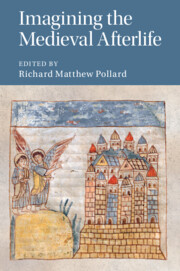Book contents
- Imagining the Medieval Afterlife
- Cambridge Studies in Medieval Literature
- Imagining the Medieval Afterlife
- Copyright page
- Contents
- Figures
- Contributors
- Preface and Acknowledgements
- Abbreviations
- Imagining the Medieval Afterlife: Introduction
- Part I Chronological Surveys
- Part II Theological Perspectives
- Part III Artistic Impressions
- Part IV Notable Authors and Texts
- Chapter 12 Visions and the Afterlife in Gregory’s Dialogues
- Chapter 13 The Vision of Tnugdal
- Chapter 14 The Afterlife in the Visionary Experiences of the Female Mystics
- Chapter 15 Dante’s Other-Worldly Surprises and This-Worldly Polemic
- Bibliography
- Index
- Cambridge Studies in Medieval Literature
Chapter 15 - Dante’s Other-Worldly Surprises and This-Worldly Polemic
from Part IV - Notable Authors and Texts
Published online by Cambridge University Press: 07 December 2020
- Imagining the Medieval Afterlife
- Cambridge Studies in Medieval Literature
- Imagining the Medieval Afterlife
- Copyright page
- Contents
- Figures
- Contributors
- Preface and Acknowledgements
- Abbreviations
- Imagining the Medieval Afterlife: Introduction
- Part I Chronological Surveys
- Part II Theological Perspectives
- Part III Artistic Impressions
- Part IV Notable Authors and Texts
- Chapter 12 Visions and the Afterlife in Gregory’s Dialogues
- Chapter 13 The Vision of Tnugdal
- Chapter 14 The Afterlife in the Visionary Experiences of the Female Mystics
- Chapter 15 Dante’s Other-Worldly Surprises and This-Worldly Polemic
- Bibliography
- Index
- Cambridge Studies in Medieval Literature
Summary
Dante’s distinctive political theology lies behind two of the most startling surprises of his otherworldly vision, in relation to previous traditions both popular and learned about the afterlife. First, of the approximately 300 characters in Dante’s otherworld, 84 are pagans, and 51 of these are located in a region entirely of Dante’s own invention: the limbo of the virtuous pagans. Second is Dante depiction of contemporary popes, at least four of whom are allotted a place in hell.
- Type
- Chapter
- Information
- Imagining the Medieval Afterlife , pp. 286 - 302Publisher: Cambridge University PressPrint publication year: 2020
- 1
- Cited by

